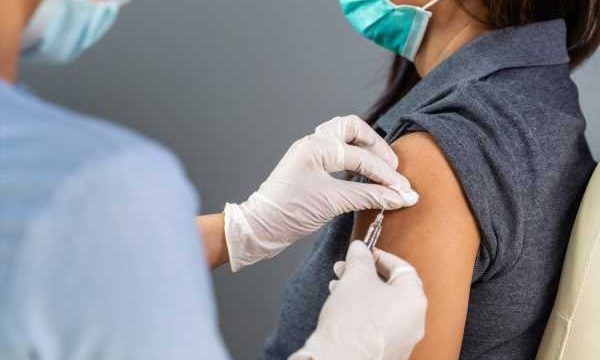Massive vaccination programs throughout the world have led to significant protection against SARS-CoV-2 infection and severe diseases. However, there has been an increase in breakthrough infections during late 2021 and early 2022 among vaccinated individuals due to the replacement of the Delta variant with the Omicron variant.
Therefore, the waning of protection for different vaccines and the number of doses that are received must be urgently estimated. Although previous studies have quantified vaccine effectiveness (VE) against symptomatic SARS-CoV-2 infection, the estimates have been arbitrating.

A new study posted to the pre-print server medRxiv* aimed to estimate the waning of vaccine protection by performing a systematic literature review of studies that reported VE at different times post-vaccination.
About the study
The study involved screening abstracts and titles of preprints and peer-reviewed journals in English for the identification of manuscripts on VE against SARS-CoV-2 infection (including both symptomatic and asymptomatic infection) as well as a symptomatic disease until 21st June 2022. Thereafter, the full texts of the manuscripts were scrutinized according to the current study’s eligibility criteria that included estimation of VE after the primary vaccination dose (comprising the first two doses) as well as a booster dose, comparison of the risk of infection between vaccinated and unvaccinated individuals, VE estimation for two defined time intervals, information on circulating variants during the assessment of VE, and estimation of VE for all age-groups that are eligible for vaccination.
Studies that measured VE during the first 14 days of administration of the vaccine and those comprising less than 20 infections in a vaccinated group were excluded from the analysis.
Study findings
The results indicated that out of the 39 articles that reported evidence of VE only ten articles matched the eligibility criteria and provided VE estimation for the mRNA-1273, BNT162b2, and ChAdOx1 nCoV-19 vaccines against Alpha, Omicron, or Delta variants. The VE 14 days post-second dose of mRNA-1273 and BNT162b2 was observed to be 94.7% and 92.45%, respectively against the Delta (symptomatic and asymptomatic) variant. Although a similar VE for ChAdOx1 nCoV-19 was observed in Quebec, the VE was found to be lower as compared to the other two vaccines after the second dose as well as 3 months after vaccination in British Columbia and the UK.
No VE difference against Delta was observed at 9 months post-vaccination for ChAdOx1 nCoV-19 and mRNA-1273. However, a decline in VE was observed in the case of BNT162b2 against both Delta and Omicron infections. The VE against Omicron infection for three doses of BNT162b2 was observed to be 82.4%, 31.5%, and 19.0%, respectively at 14 days, at 6, and 9 months post administration of the last vaccine dose.
The results also reported the VE 14 days post administration of the second dose for BNT162b2, ChAdOx1 nCoV-19, and mRNA-1273 to be 93.6%, 76.2%, and 96.2%, respectively against symptomatic Delta infections. The corresponding VE against symptomatic Omicron infection was observed to be 83.6%, 56.1%, and 76.3% for mRNA-1273, ChAdOx1 nCoV-19, and BNT162b2, respectively.
The VE was observed to decline to 40.2%, 64.4%, and 74.1% for ChAdOx1 nCoV-19, BNT162b2, and mRNA-1273, respectively, at 6 months post-second dose against symptomatic Delta infections. The VE against symptomatic Omicron infection at 6 months post the second dose was observed to be 12.0%, 7.5%, and 8.3% for mRNA-1273, ChAdOx1 nCoV-19, and BNT162b2, respectively. The VE against symptomatic Omicron infection at 9 months post-vaccination was observed to be below 5 % for all the vaccines. Moreover, the VE for booster dose against symptomatic Omicron infection was observed to be between 11.7% and 22.2%.
Therefore, the current study demonstrated that Omicron infection and symptomatic disease were associated with significant immune escape following two doses of vaccination. However, booster doses could restore vaccine protection to levels similar to those observed soon after the second dose. They could also reduce the speed of waning. However, the continuous emergence of new Omicron sub-lineages or other potential future variants of SARS-CoV-2 requires further vaccination efforts to prevent the resurgence of COVID-19 patients.
Limitations
The study has certain limitations. First, the sample size of the study was quite small. Second, the duration of the follow-up period for the effectiveness of booster doses was limited. Third, preferential testing of symptomatic individuals may have led to bias. Fourth, different study designs might have impacted original estimates of vaccine effectiveness. Finally, recent studies indicate that hybrid and natural immunity are more durable as compared to vaccine-induced immunity.
*Important notice
medRxiv publishes preliminary scientific reports that are not peer-reviewed and, therefore, should not be regarded as conclusive, guide clinical practice/health-related behavior, or treated as established information.
- Menegale, F. et al. (2022). Waning of SARS-CoV-2 vaccine-induced immunity: A systematic review and secondary data analysis. medRxiv. doi: https://doi.org/10.1101/2022.07.04.22277225 https://www.medrxiv.org/content/10.1101/2022.07.04.22277225v1
Posted in: Medical Science News | Medical Research News | Disease/Infection News
Tags: Coronavirus Disease COVID-19, covid-19, immunity, Omicron, SARS, SARS-CoV-2, Vaccine

Written by
Suchandrima Bhowmik
Suchandrima has a Bachelor of Science (B.Sc.) degree in Microbiology and a Master of Science (M.Sc.) degree in Microbiology from the University of Calcutta, India. The study of health and diseases was always very important to her. In addition to Microbiology, she also gained extensive knowledge in Biochemistry, Immunology, Medical Microbiology, Metabolism, and Biotechnology as part of her master's degree.
Source: Read Full Article
